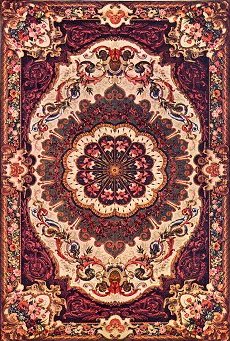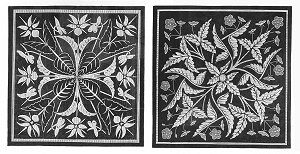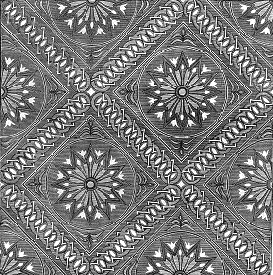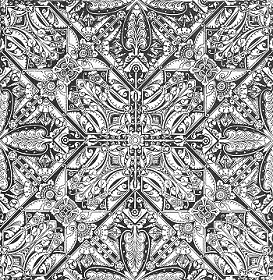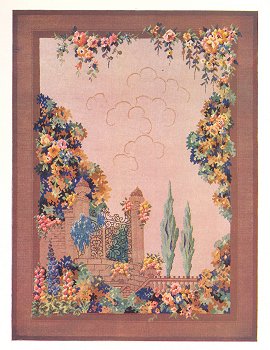|
George Wallis seems always to have had strong views on the design of carpets and other floor coverings. His earliest recorded views appear in the Special Report he made on his return from the USA in 1854, when he turned his critical eye upon carpets and other floor coverings. Amongst the technical details of the factories and their manufacturing methods he notes that The Lowell Manufacturing Company of Massachusetts uses designs which are "varied and of the usual character of such goods. The designers employed are French and Scotch. Two female students of the the Boston School of Design are engaged who ... have made one or two very creditable attempts in design". The designs of the Bigelow Company, also of Massachusetts, "are of the usual character, chiefly floral, though a few good geometric diapers indicated a tendency to a more healthy style". All this is, at best, damning with faint praise. But when it comes to floor-cloth, the glows are off. Of those he saw at the New York Exhibition of 1853 he remarks:
On the English scene, in his paper of
1856 Wallis deals in some details with various classes of goods and of
carpets he has this to say: “Yet some progress has
been made even in carpet design, which, a few years ago, appeared to be
hopelessly abandoned to an incessant ringing of the changes upon
artistic pit falls, man-traps and floral stumbling blocks in velvet pile
and terry fabrics in wool.
A few manufacturers, as also a few dealers, seem to have arrived at a
point that, inasmuch as a carpet is a covering for a floor, it ought to
look like a floor – that is, a surface to walk upon – that a carpet is
not the only article in the room
and that its lines and colours ought to be subordinate to the
more prominent pieces of furniture, than to challenge attention by the
brilliancy of its hues in masses, or the tortuosity of its lines in the
boundaries of its forms. A
conviction too has arisen that forms in projection are inconsistent with
the position of the surface on which they are represented; and that,
even granting that flowers, tastefully arranged, are not unsuitable
objects for the decoration
of a carpet, yet there is no reason why the flower basket should be
represented too. The
statement that floral designs in carpets are still preferred by the
customers, and that ladies especially, in spite of the best geometric
designs, insist upon roses done in wool, is a fair enough argument in
its commercial application, but in an artistic sense only proves that
the people lack a knowledge of the principles by which to test these
things”.
Carpets clearly fascinated those present and Ruskin was not slow to leap in and grab the wrong end of the stick. He said that the audience “had heard an ungallant attack upon the ladies for promoting a base manufacture of carpets. He could not blame the ladies in this ....”. But his reason for this seems to be that the world’s largest manufacturer of carpets made many “green carpets, in which floral design was largely introduced, and, he believed, generally to the satisfaction of the public”. And neither “could he see, since the first thing we did to make ground fit to be walked upon by any festive procession, was always to strew flowers upon it, why we should refuse to have flowers on our carpets, lest we should stumble on them, any more than we should refuse to have pictures on our walls lest we should knock our heads through them”.
In the further debate Wallis did not deal with Ruskin’s argument that what was to the general satisfaction of the public was acceptable design, probably doubting that Ruskin could have meant it. Nor did he have to deal directly with Ruskin’s assertion that Wallis would not have flowers on a carpet because Mr. J. G. Crace – the famous and fashionable interior decorator - pointed out that Wallis had not said that. Crace went on to make a good point, which Wallis’s writings elsewhere show he would have agreed with, that a design “should be adapted to the nature of the material; the stitches, so to call them, of a carpet had a certain size, and it was not possible, to imitate the shadows as accurately as by the brush, and he maintained that the beauty of flowers on a carpet was increased by such breadth in the lights and shadows of the flowers as would preserve the flatness so essential to the suitableness of a carpet design”.
At this point we can mention Thomas Gradgrind’s contribution to this matter. Charles Dicken’s “Hard Times” was
published in 1854, two years before this lecture.
Chapter 2 is worth quoting extensively.
In it Mr Gradgrind and his friend are examining the pupils at
Gradgrind’s model school: ‘Very well,’ said this gentleman, briskly smiling, and folding his arms. ‘That’s a horse. Now, let me ask you girls and boys, Would you paper a room with representations of horses?’ After a
pause, one half of the children cried in chorus, ‘Yes, sir!’ Upon which
the other half, seeing in the gentleman’s face that Yes was wrong, cried
out in chorus, ‘No, sir!’ — as the custom is, in these examinations. Perhaps the remarkable thing about this is that Hard Times was published in 1854, two years before the Wallis- Ruskin spat. Perhaps neither of them had got round to reading it or, if they had, they chose to ignore it. Eventually it was Christopher Dresser
who obliged Thomas Gradgrind by laying down the rules for carpets. In his Principles of Decorative Design (undated) he stated
“in axiomatic form, the conditions which govern the application of
ornament” to carpets. There
were eight of them, of which the fifth is: A carpet should, in some
respects, resemble a bank richly covered with flowers; thus, when seen
from a distance the effect should be that of a general "bloom" of
colour; when viewed from a nearer point it should present certain
features of somewhat special interest; and when looked at closely new
beauties should make their appearance. And the sixth is:
In 1871 too The Art Journal
Catalogue of the International Exhibition, 1871, was published,
again with Wallis acting as commentator and critic.
We can get some idea of Wallis’s design principles from what he writes
here. He says of carpets: “Twenty
years ago nothing could possibly be more inappropriate than the whole
mass of designs executed for carpets;
but now the fact that the carpet is a decorated covering for the floor,
and that the floor is a horizontal place to be walked upon, and that the
design ought not to contradict these facts, seem to be pretty generally
understood and acted upon, thanks to the incessant attention, and
consistent action, of a few able artists, such as Mr. Owen Jones, Sir M
D Wyattt and Dr. Dresser, whose attention to this department of
industrial design has had a marked influence on its present position”. This is certainly an idea of “appropriateness” of design. But note too that Wallis refers to artists (not to designers or ornamenters) and claims no credit for himself. He never did, directly, but this does reflect his feeling that it was in the traditional arts that the basis of good design was to be found. He does not seem to have gone along with Dresser’s view of ornament abstracted from nature as being a higher form of art and ornamentation – but nevertheless he seems to have appreciated what Dresser was trying to do and is one of the few Victorian design gurus to give him a mention. Wallis talked about carpet design again in his "Decorative Art in Britain" published in 1877. At one point he is arguing against a speech given the year before by Mr. Mark Pattison, the Rector of Lincoln College, Oxford, which had been critical of the art and design education movement, claiming that it had achieved nothing and that the point was proved by, inter alia, the bad design of carpets. Wallis says:
Perhaps Wallis was a little too optimistic. Abominations of realistic flowers continued to be available and the battle of the carpets was to go on a long time. Joanna Banham, Sally Macdonald and Julia Porter, in their Victorian Interior Style, Cassell, 1991, say of William Morris’ carpets: “their patterns were uncompromisingly two dimensional. Morris had a particular dislike of the cabbage-rose and scrollwork designs popularised in the mid-century and, like other reformers of domestic design, he argued that the illusionism of these motifs was both inappropriate and visually disturbing on a flat and solid surface like a floor.” But even if Wallis (who was still very much around at the time) could have said “I told you so”, he might also have had to admit that his education of manufacturers and the public in the tasteful design of carpets had not succeeded – yet.
For further and later example we can
take A History of British Carpets by C. E. C. Tattersall, Lewis,
1934.
Tattersall was in the Department of Textiles at the Victorian and
Albert Museum. He writes: “In the matter of design, few know, or appreciate, the enormous amount of thought and trouble expended by carpet makers. Even nowadays, large majority of carpet users know or care little about design as such; but they look at carpets before buying them and they will, perhaps for inscrutable reasons, choose some and reject others. The manufacturer must see to it that he has plenty of the first sort to offer, whatever his own opinions may be. There are others who want to march with the times: they must have modern patterns even if they do not really like them. They must also be catered for, and yet who is to say how soon their taste will alter and how soon a successful pattern will lose its popularity? Perhaps there is less real difficult to in supplying those who demand something that is truly beautiful. Fine reproductions and good original designs can be produced with a reasonable degree of certainty, and are not likely to fall out of favour and remain unsold. The last class of customers, it may be believed, is loudest in its criticism of the manufacturers for supplying those less worthy products that the public insists on having.” |
